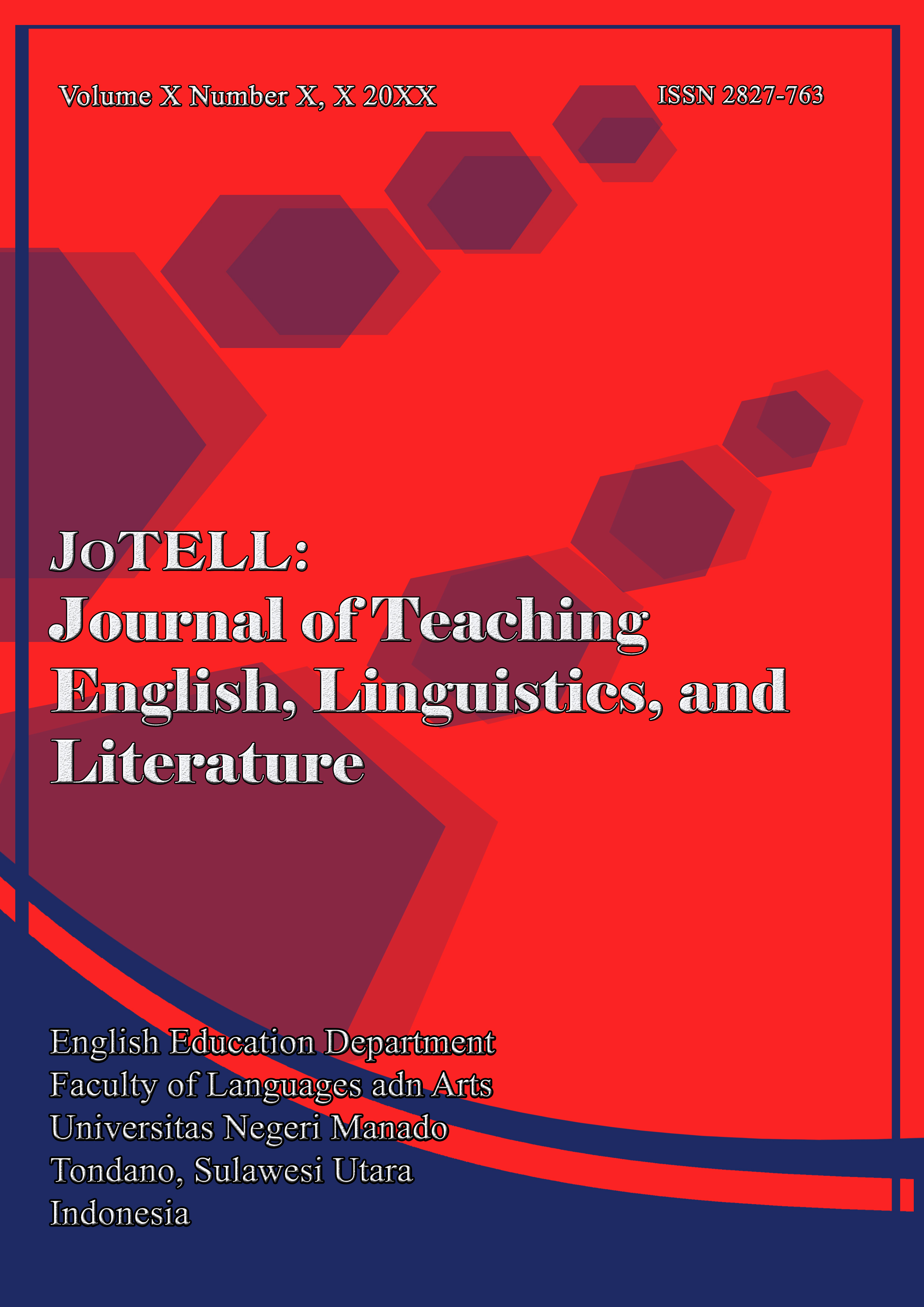The Correlation Between Vocabulary Mastery And Reading Comprehension In English at SMP Negeri 4 Tondano
DOI:
https://doi.org/10.36582/jotell.v4i2.11333Keywords:
The Correlation, Vocabulary, Reading Comprehension.Abstract
The purpose of this study is to investigate the potential relationship between vocabulary mastery and reading comprehension. The study was carried out at SMP Negeri 4 Tondano, with students in grades 8 B, which consist of a total of 26 students. A vocabulary mastery test and reading comprehension questionnaire with the (David, 1974) score were used to collect the data, which were then manually correlated using the Pearson Product-Moment method for analysis. The correlation coefficient, or r, between vocabulary mastery and reading comprehension is 0.783 according to the Pearson Product Moment Correlation Coefficient. The study's result indicates that vocabulary mastery at SMP Negeri 4 Tondano and reading comprehension are highly correlated. It was shown that there was a strong correlation between vocabulary mastery in English classes and their level of reading comprehension. It is required to students to actively seek out feedback from classmates and teachers
References
Basco, L. M., & Han, S.-H. (2016). motivation, and anxiety of Korean university students. Journal of Language Teaching and Research, 7(6), 1069.
Bishry, Hasanul. 2018. “The Correlation Between Vocabulary Mastery and Reading Comprehension.†Tarbawi : Jurnal Ilmu Pendidikan 14(2):63. doi: 10.32939/tarbawi.v14i2.292.
Brown, Douglas H. 2001. Teaching by Principles An Interactive Approach Language Pedagogy. New York: Addison Wesley Longman.
Cameron, L. (2001). Teaching Languages to Young Learners. Cambridge.
Devi, Ruhma, Yudi Juniardi, and Syafrizal. 1967. “Improving Students’ Reading Comprehension and Writing Ability of Narrative Text through Story Map Strategy.†Angewandte Chemie International Edition, 6(11), 951–952.
Duffy, Gerald. D. (2009). Explaining Reading: A Resource for Teaching Concepis, Skills, and Strategies. London: The Guilford Press.
Ganie, Rohani, and Rahmadsyah Rangkuti. 2019. “Reading Comprehension Problems on English Texts Faced By High School Students in Medan.†2019:684–94. doi: 10.18502/kss.v3i19.4896.
Grabe, W & Stoller, F. 1 (2002). Teaching and Researching Reading. Britain: Pearson Education.
Harmer, J. (2001). The Practice of English Language Teaching. Cambridge.
Movie, Tonya. 2021. “Journal of Arts and Humanities.†25(2004):128–34.
Maru, M. G., Tamowangkay, F. P., Pelenkahu, N., & Wuntu, C. (2022). Teachers’perception toward the impact of platform used in online learning
communication in the eastern Indonesia. International Journal of Communication and Society, 4(1), 59-71.
Liando, N. V., Sahetapy, R. J., & Maru, M. G. (2018). ENGLISH MAJOR STUDENTS’PERCEPTIONS TOWARDS WATCHING ENGLISH MOVIES IN LISTENING AND SPEAKING SKILLS DEVELOPMENT. Advances in Social Sciences Research Journal, 5(6).
Liando, N. V., Dallyono, R., Tatipang, D. P., & Lengkoan, F. (2023). Among English, Indonesian and local language: Translanguaging practices in an Indonesian EFL classroom. Indonesian Journal of Applied Linguistics, 13(1), 204-216.
Liando, N. V. F., & Tatipang, D. P. (2022). English or Indonesian language? Parents’ perception toward children's second language learning context. Jurnal Lingua Idea, 13(1), 61-75.
Tatipang, D., Oroh, E. Z., & Liando, N. V. (2021). THE APPLICATION OF MIND MAPPING TECHNIQUE TO INCREASE STUDENTS’READING COMPREHENSION AT THE SEVENTH GRADE OF SMP. Kompetensi, 1(03), 389-397.
Liando, N. V. F., Tatipang, D. P., & Wuntu, C. N. (2023). First Language Interfere in EFL Classes: Revealing Students’ Perspectives and Teachers’ Reasons in ELL. REiLA: Journal of Research and Innovation in Language, 5(1), 77-88.
Liando, N. V. F., Tatipang, D. P., Tamboto, G., Poluan, M., & Manuas, M. (2022). Pictures as a learning media in teaching vocabulary. Jurnal Ilmiah Universitas Batanghari Jambi, 22(3), 1944-1949.
Liando, N. V., Tatipang, D. P., & Lengkoan, F. (2022). A study of translanguaging practices in an EFL classroom in Indonesian context: A multilingual concept. Research and Innovation in Language Learning, 5(2), 167-185.
Muijs, D (2004). Doing Quantitative Research in Education with SPSS.
Ningsih, Ni, Luh Widhiasih, and Nengah Handayani. 2021. “The Correlation Between Vocabulary Mastery and Reading Comprehension of the Seventh-Grade Students of Smpn 2 Kuta Utara in Academic Year 2020/ 2021.†Academic Journal on English Studies 1(2).
Nunan, D. (2003). Language Teaching Methodology: A Texibook for Teachers. New York.
Nurfidah, N. 2021. “Penguasaan Materi Keterampilan Membaca Mahasiswa S1 Program Studi Pendidikan Bahasa Dan Sastra Indonesia Stkip Harapan Bima.†BAHTRA: Pendidikan Bahasa Dan Sastra 2(1):1–4.
Nurhadi. (2008). Membaca Cepat dan Efektif. Bandung: Sinar Baru Algensindo.
Oullette. (2006). What's Meaning Got to Do with It: The Role of Vocabulary in Word Reading and Reading Comprehension. Journal of Educational Psychology. Vol. 98 number 3.
Rorintulus, O., Wuntu, C. N., Tatipang, D. P., Karisi, Y., Kicha, L., Tineh, S.,&
Pratasik, G. (2024). Literary-Based ELT: Alternatives for Creative and
Innovative English Learning. Penerbit Tahta Media.
Samola, Nurmin. 2023. “The Implementation of Games in Vocabulary Learning at
the English Education Department FBS UNIMA.†Journal of English Culture, Language, Literature and Education 11(1):125–45
Mogea, T. (2022). IMPROVING STUDENTS’VOCABULARY THROUGH DISPLAY TABLE GAME. Jurnal Pendidikan dan Sastra Inggris, 2(3), 172-184
Downloads
Published
How to Cite
Issue
Section
License
Copyright (c) 2025 JoTELL : Journal of Teaching English, Linguistics, and Literature

This work is licensed under a Creative Commons Attribution-ShareAlike 4.0 International License.












